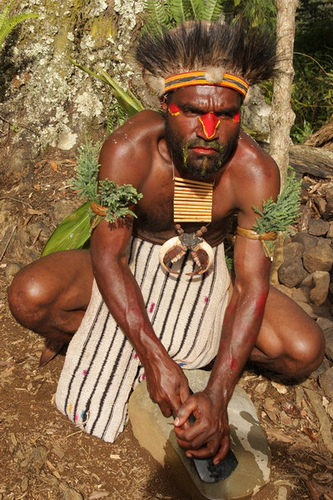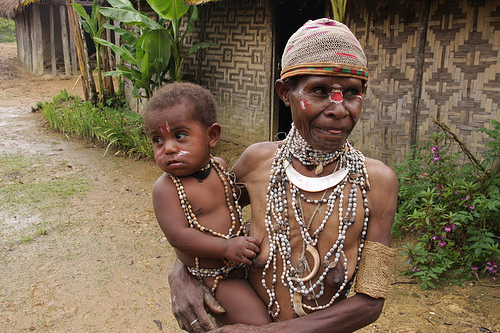 It’s been a very very long time since I sat down with a guide book to read up on a destination that I know little about. Last week my Lonely Planet guide to Papua New Guinea arrived from Amazon.
It’s been a very very long time since I sat down with a guide book to read up on a destination that I know little about. Last week my Lonely Planet guide to Papua New Guinea arrived from Amazon.
PNG is a country that I’ve wanted to visit for something like 20 years. I’ve seen the exotic photos of the local tribesman. I’ve read about their propensity toward (until recently) cannibalism. And I’ve heard that PNG is one of the most difficult places to travel to and, at least in the city of Port Moresby, one of the most dangerous in the world. I’ve also heard that the singsings (festivals) are the most magnificent one can ever experience and that the wildlife is some of the most diverse on the planet.
But for me, it’s mostly about the people. I’ve always had a fascination with indigenous cultures and it seems that other than the tribes of the Brazilian rainforest (which has also been on my list for something like 20 years), you can’t get any more indigenous than those in PNG.
So it was last week that I snuggled up with my guidebook and started highlighting some important facts concerning PNG, a destination that I will likely visit this summer in preparation for a tour that I’ll lead in 2011. The feeling that I got while reading this brought me back to my early 20s when I was planning for a circle-the-Pacific trip. I knew little about Asia at the time and I can so vividly remember cracking open all of my guidebooks to  learn about Vietnam, Cambodia, Laos, Thailand, Singapore and Indonesia (countries that I’ve now visited and revisited countless times).
learn about Vietnam, Cambodia, Laos, Thailand, Singapore and Indonesia (countries that I’ve now visited and revisited countless times).
I’m glad to say that my budget is a bit bigger than in my early days of travel but, unfortunately, my time is more squeezed.
So, I’m planning the short time that I have in-country carefully and taking note of some of the more unique facts about PNG. These are some of my favorites:
- pigs are considered family members and it’s not unheard of for a lactating woman to suckle piglets
- more than 800 languages are spoken in PNG – 12% of the world’s indigenous languages
- Pidgin is most commonly spoken and words can often be easily recognized by English speakers. For example, “What’s your name?” is “”Wanem nem bilong yu?” Not too hard – huh?
- cannibalism was practiced for ritualistic reasons until the 60s.
There are plenty of destinations I have yet to explore, like Eastern Europe and Antarctica. But I don’t think any of these will hold the same amount of awe for me when I first crack open that guidebook to learn more about them. PNG seems to so far off the charts of what I know that I’m giddy with delight just reading about it!
Travel Well!
Beth
Related links:
The Google Factor – Ethical Travel
Wanderlust and Lipstick Tours
Join other Wanderlusters and stay updated on travel-related items by subscribing via email or RSS feed.
All photos – MAG – Michael Gonnen
Ooh, I’m going to PNG later this year, too! Funny.
Hey Beth,
Can’t wait to hear about the trip to PNG…I went to Indonesia last year and spent 3 months working my way across Flores and Timor on my way to Papua and had to turn back – they stopped issuing the selat jelan (travel permit) because of violence in Papua.
I’m still planning on getting there this year or next, if you beat me to it I want some tips! 🙂
Cheers,
Greg
Startbackpacking.com
Hi Beth,
as a Papua New Guinean living in Europe for some time, I am proud to admit that you have chosen to visit the land of the unexpected. Yes, PNG is truly many countries packed into one, so diverse in almost everything, from languages to traditions, culture, even food and more. It may prove difficult to get around, but it is worth is as you will not gain a similar experience from another country. I wish you a good trip and looking forward to reading your updates later on.
Tine
University College Dublin (UCD)
Ireland
Read more! I’ve been back another time since that post. Just click on Papua New Guinea under the categories at right, you’ll see more photos and stories 🙂